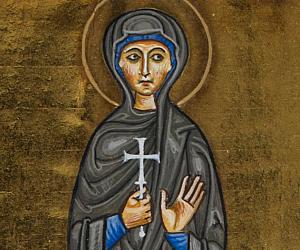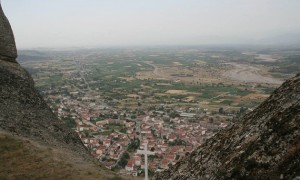The God of the New Testament in the Old Testament (part 3)
27 April 2017
“If you believed Moses, you would believe me; for he wrote of me” (John 5:46)
The most famous theophany in the Old Testament is the appearance of God to Moses in the burning bush (Exodus 3:1-5):
“Now Moses was tending the flock of Jethro his father-in-law, the priest of Midian, and he led the flock to the far side of the desert and came to Horeb, the mountain of God. There the angel of the Lord appeared to him in flames of fire from within a bush. Moses saw that though the bush was on fire it did not burn up. So Moses thought, “I will go over and see this strange sight—why the bush does not burn up.” When the Lord saw that he had gone over to look, God called to him from within the bush, “Moses! Moses!” And Moses said, “Here I am.” “Do not come any closer,” God said. “Take off your sandals, for the place where you are standing is holy ground.” Then he said, “I am the God of your fathers, the God of Abraham, the God of Isaac and the God of Jacob.” At this, Moses hid his face, because he was afraid to look at God”.
Before we go any further, something must be said about ‘the angel of the Lord’ that appeared to Moses ‘in flames of fire from within the bush’.
The Angel of Great Counsel
Patristic teaching holds that ‘the Angel of the Lord’ is one of the many names of God the Word in the Old Testament. It is, in fact, one of the earliest titles. ‘The Angel of the Lord’ refers not to one of the bodiless powers of heaven, but to the pre-incarnate Christ. Angel means messenger, and in the Old Testament an “angel” was not necessarily one of the heavenly court – it could also be a human being. The Word is God’s messenger par excellence. Thus St Justin Martyr repeatedly refers to Christ as an Angel. The primary source for Justin and other Church Fathers was probably the Septuagint translation of Isaiah 9:6:
“For a child is born to us, and a son is given to us, whose government is upon his shoulder: and his name is called the Angel of Great Counsel: for I will bring peace upon the princes, and health to him”.
And yet Justin, despite his copious use of the term ‘Angel of the Lord’ or ‘Angel of Great Counsel’, never attempts to clarify that the Angel is the Word of God, for that Christ was called Angel was obvious to anyone who was familiar with the Septuagint Isaiah 9:6. Since it was widely acknowledged that Isaiah 9:6 refers to the Messiah, the title “Angel of Great Counsel” refers also to Christ, and thus it also follows that Christ is the Angel of the Lord who appears to the Prophets of the Old Testament (e.g. Genesis 15–22; Genesis 28–35; Exodus 3, Joshua 5-6).
Justin argued from the appearances of the Angel in the Old Testament that this Angel is God Himself. This is explained by Günther Juncker in his treatment of the subject:
‘It does not take Justin long to point out from the Old Testament appearances of the Angel of the Lord that this Angel is fully God. Invariably when this particular Angel is seen, those who have seen him declare that they have seen God and are amazed that they have lived. In numerous places this Angel speaks in the first person as Lord and God, receives worship and sacrifices, and makes the very ground on which he stands holy; yet in other places he speaks of God in the third person and is functionally subordinate since, as Angel, he is sent by God to deliver a message from God. When these passages were combined with others (e.g. Gen 1:26; 24 19:24; Ps 45:6–7; and 110:1) which on the surface seem to speak of a plurality of persons in the Godhead, Justin’s argument became irrefutable. Thus in a key passage which mentions the title Angel four times in relation to the Old Testament theophanies, Justin can hardly be held guilty of an overstatement when he says of Christ that “He is called God, He is God, and shall always be God” (Dial. 58)’ (“Christ As Angel: The Reclamation Of A Primitive Title,” Trinity Journal 15:2 (Fall 1994): 221–250.)
In his Dialogue with Trypho, Justin writes:
‘He who is called God and appeared to the patriarchs is called both Angel and Lord, in order that from this you may understand Him to be minister to the Father of all things… He… appeared as a man to Abraham, and… wrestled in human form with Jacob’ (LVIII)
Even Novatian argued that the Angel of Great Counsel was more than just an angel:
“…the name God has never been granted to angels…He is entitled ‘The Angel of Great Counsel” (On the Trinity, XVIII)
St Paulin his Epistle to the Hebrews writes:
‘For to which of the angels did God ever say, “You are my Son; today I have begotten you”? Or again, “I will be his Father, and he will be my Son”?’ (Heb. 1:5. See also Psalm 2:7)
It is clear from the account of the Burning Bush that the Angel of the Lord who appears to Moses is God Himself: “I am the God of your fathers, the God of Abraham, the God of Isaac and the God of Jacob”. “And the Lord spoke to Moses face to face, as a man speaks to a friend”. (Exodus 33:11). “Since then, no prophet has risen in Israel like Moses, whom the Lord knew face to face” (Deut. 34:10). And yet Christ Himself said, “No one has seen the Father except the one who is from God; only he has seen the Father”. (John 6:46) “No one has seen God at any time; the only begotten Son who is in the bosom of the Father, He has made Him known” (John 1:18). Do the words of Christ contradict what is written in Exodus and Deuteronomy? By no means, for while Moses did indeed see God, he did not see the Father; he saw the Son. This is alluded to in the New Testament when Christ says: “Before Abraham was, I AM” (John 8:58). Some commentators see here an allusion to the words of God in Exodus when Moses asks for God’s name, and the Lord replies (in the Septuagint), “I am the One who is”, or, “I am the Living One”; (in the Hebrew), “I am that I am”. ‘You shall say…”I AM has sent me to you”.’
In his Dialogue with Trypho, St Justin emphasises that the Father has never been seen by human eyes, and it is therefore the Son Who appeared to Moses in the Burning Bush:
“Neither Abraham, nor Isaac, nor Jacob, nor any other man, ever saw the Father and Ineffable Lord of all things…; but the One who according to his will is both God his Son and his Angel ministering to his will, whom he determined should be born as man of a Virgin, and who once even became fire when he conversed with Moses from the bush”. (Dial. 127)
Sinai, Horeb and Tabor
That the Word of God was made manifest to Moses is made clearer when one considers the revelation of divine glory on another mount, this time in the New Testament. In St Matthew’s Gospel (17:1-9), we read of the Transfiguration of Jesus Christ onMountTabor(see also Mark 9:2-8, Luke 9:28-36):
‘After six days Jesus took with him Peter, James and John the brother of James, and led them up a high mountain by themselves. There he was transfigured before them. His face shone like the sun, and his clothes became as white as the light. Just then there appeared before them Moses and Elijah, talking with Jesus. Peter said to Jesus, “Lord, it is good for us to be here. If you wish, I will put up three shelters—one for you, one for Moses and one for Elijah.” While he was still speaking, a bright cloud enveloped them, and a voice from the cloud said, “This is my Son, whom I love; with him I am well pleased. Listen to him!” When the disciples heard this, they fell facedown to the ground, terrified. But Jesus came and touched them. “Get up,” he said. “Don’t be afraid.” When they looked up, they saw no one except Jesus.’
Why do Moses and Elijah appear before Christ onMountTabor?: to illustrate that Christ is the God Who appeared to Moses on Mount Sinai and to Elijah onMountHoreb. Let us take a closer look at these two Old Testament theophanies:
On Mount Sinai:
‘…Moses said, “Now show me your glory.” And the Lord said, “I will cause all my goodness to pass in front of you, and I will proclaim my name, the Lord, in your presence. I will have mercy on whom I will have mercy, and I will have compassion on whom I will have compassion. But,” he said, “you cannot see my face, for no one may see me and live.” Then the Lord said, “There is a place near me where you may stand on a rock. When my glory passes by, I will put you in a cleft in the rock and cover you with my hand until I have passed by. Then I will remove my hand and you will see my back; but my face must not be seen”.’ (Exodus 33:18-23)
On Mount Horeb:
Elijah “…came to a cave, and lodged there; and, behold, the word of the Lord came to him, and he said to him, “What are you doing here, Elijah?” And he said, “I have been very jealous for the Lord God of hosts: for the children of Israel have forsaken your covenant, thrown down your altars, and slain your prophets with the sword; and I, only I, am left; and they seek my life, to take it away. And he said, Go, and stand upon the mount before the Lord. And, behold, the Lord passed by, and a great and strong wind rent the mountains, and broke in pieces the rocks before the Lord; but the Lord was not in the wind: and after the wind an earthquake; but the Lord was not in the earthquake: And after the earthquake a fire; but the Lord was not in the fire: and after the fire a still small voice. And it was so, when Elijah heard it, that he wrapped his face in his mantle, and went out, and stood in mouth of the cave. And he heard a voice saying to him: What are you doing here, Elijah?”.’ (1 Kings 19: 8-13)
In the Orthodox Church these two texts are read at Vespers on the Feast of the Transfiguration, and thus the Church provides an interpretation of the Transfiguration by its comparison with these two Old Testament theophanies. In Exodus 24, God’s glory descends on the Mount and Moses enters the cloud. In Matthew17, abright cloud envelopes the apostles. In Exodus 24, God passes before Moses’ face and Moses falls to the ground and worships Him. In 1 Kings 19, Elijah reacts to God’s presence in a similar manner: ‘he wrapped his face in his mantle and stood by the cave’, while in Matthew 17 the apostles also respond to God’s glory in a similar fashion.
These three manifestations of divine glory on a mount are all manifestations of the Word of God. In the Transfiguration, the God Who appeared to Moses on Sinai and to Elijah on Horeb is now become flesh, and on Tabor He reveals to the apostles His divine glory.
All of this illustrates that when we read the Old Testament in light of the New, and the New in light of the Old, we can see that Christ is indeed “the same yesterday, today and forever” (Heb. 13:8).












